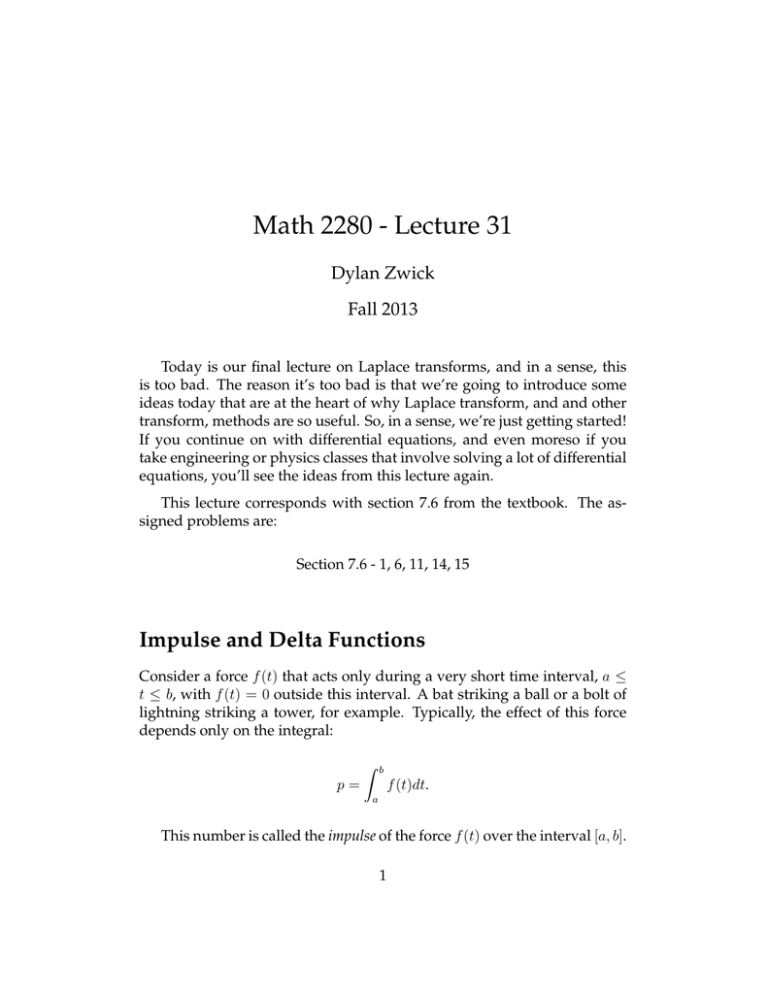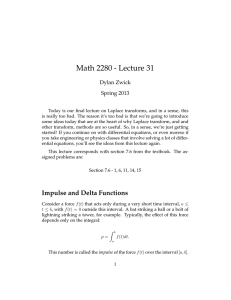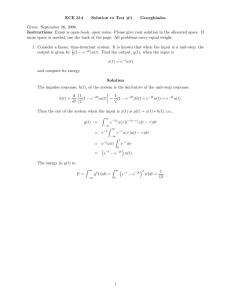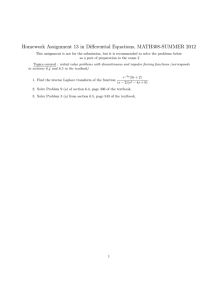Math 2280 - Lecture 31 Dylan Zwick Fall 2013
advertisement

Math 2280 - Lecture 31 Dylan Zwick Fall 2013 Today is our final lecture on Laplace transforms, and in a sense, this is too bad. The reason it’s too bad is that we’re going to introduce some ideas today that are at the heart of why Laplace transform, and and other transform, methods are so useful. So, in a sense, we’re just getting started! If you continue on with differential equations, and even moreso if you take engineering or physics classes that involve solving a lot of differential equations, you’ll see the ideas from this lecture again. This lecture corresponds with section 7.6 from the textbook. The assigned problems are: Section 7.6 - 1, 6, 11, 14, 15 Impulse and Delta Functions Consider a force f (t) that acts only during a very short time interval, a ≤ t ≤ b, with f (t) = 0 outside this interval. A bat striking a ball or a bolt of lightning striking a tower, for example. Typically, the effect of this force depends only on the integral: p= Z b f (t)dt. a This number is called the impulse of the force f (t) over the interval [a, b]. 1 An example of this is that the change in momentum of a particle is determined by the impulse of the force acting upon it. This is nice because frequently we don’t know exactly what the force f (t) is, but we can figure out what the integral above, the impulse, is, and it turns out that’s really all we need to know. Now, if we have a given impulse p, we may as well model it with the simplest function we can, namely, a constant function. So, if we have an impulse p = 1, we can get this impulse using the function: da,ǫ (t) = 1 ǫ a≤t<a+ǫ 0 otherwise where ǫ is the amount of time over which the impulse acts. If a > 0, then Z ∞ da,ǫ (t)dt = 1. 0 The time interval ǫ over which the impulse acts is frequently very small, and it’s difficult to get a good measure of what it is. So, we can try to model an instantaneous impulse that occurs preciesely at the time t = a. We call this instantaneous impulse the Dirac delta funciton, and we represent it as: δa (t) = lim da,ǫ (t). ǫ→0 Now, this delta function isn’t a “function” in the strictest sense. It’s 0 everywhere except at the point a, and at a it’s infinite. Infinity isn’t well defined, and a function that is 0 everywhere except at a point should integrate to 0 over any finite interval. So, what gives? Well, the Dirac delta “function” is actually a generalized function called a distribution, and is only defined in terms of how it operates on integrals. 2 Delta Functions as Operators The mean value theorem for integrals states that: Z a+ǫ g(t)dt = ǫg(t) a where t is a point in [a, a + ǫ]. It follows that: lim ǫ→0 Z ∞ g(t)da,ǫ (t)dt = lim ǫ→0 0 Z a+ǫ a 1 g(t) · dt = lim g(t) = g(a). ǫ→0 ǫ We take this as the definition of the Delta function. It’s an operator such that: Z ∞ f (t)δa (t)dt = f (a). 0 We note that if f (t) = e−st we get: Z ∞ e−st δa (t)dt = e−as . 0 We define the Laplace transform of the delta function to be: L(δa (t)) = e−as (a ≥ 0). If a = 0 this gives us: L(δ(t)) = 1. Notice as s → ∞ this Laplace transform does not go to 0, a further implication that the Delta function is not a standard type of function. 3 Delta Function Inputs Suppose we are given a mechanical system whose response x(t) to the external force f (t) is determined by the differential equation: Ax′′ + Bx′ + Cx = f (t). We want to investigate the response of this system to a unit impulse at the time t = a. It seems reasonable to express this response as the solution to the differential equation: Ax′′ + Bx′ + Cx = δa (t). But, again, δa (t) isn’t really a function, and so what would we mean by a solution to the above equation? We call x(t) a solution to the above differential equation provided that: x(t) = lim xǫ (t), ǫ→0 where xǫ (t) is a solution of the differential equation: Ax′′ + Bx′ + Cx = da,ǫ (t). The way to find x(t) is to take the Laplace transform of both sides, figure out X(s), and then figure out its inverse Laplace transform. This is how we solve these types of differential equations, and it’s the first major instance we’ve seen where Laplace transform methods are absolutely necessary. 4 Example - Solve the initial value problem: x′′ + 4x = δ(t) + δ(t − π); x(0) = x′ (0) = 0. Example - Solve the initial value problem: x′′ + 2x′ + x = t + δ(t); x(0) = 0, x′ (0) = 1. 5 More room for the example problem. 6 Systems Analysis and Duhamel’s Principle Consider a physical system in which the output x(t) to the input function f (t) is described by the differential equation: ax′′ + bx′ + cx = f (t), where the constant coefficients a, b and c are determined by the physical parameters of the system and are independent of f (t). We assume for simplicity that the system is initially passive, and so x(0) = x′ (0) = 0. The Laplace transform of the differential equation is: as2 X(s) + bsX(s) + cX(s) = F (s), and so X(s) is: X(s) = as2 F (s) = W (s)F (s). + bs + c Here the function W (s) = as2 1 + bs + c is called the transfer function of the system. The inverse Laplace transform of the transform function, w(t), is called the weight function of the system. Using our earlier results about convolutions and the above formula for X(s), we get that the solution to our system is: x(t) = Z t w(τ )f (t − τ )dt. 0 This is called Duhamel’s principle for the system, and the important thing about it is that the weight function w(t) is determined completely by the parameters of the system, and has nothing to do with the imput 7 function f (t). So, if we know the weight function, we can calculate the solution for any input by “just” calculting an integral. Now, integrals aren’t easy, but they’re easier than solving differential equations. It’s interesting (actually, it’s very interesting, for reasons we won’t explore in this class) that our weight function is actually the response of our system to a delta function input. Example - Apply Duhamel’s principle to write an integral formula for the solution of the initial value problem: x′′ + 6x′ + 9x = f (t); x(0) = x′ (0) = 0. 8 Notes on Homework Problems Problems 7.6.1 and 7.6.6 are both about solving a linear differential equation with a delta function input. These are similar to the example problems worked in these notes. Problem 7.6.11 asks you to find a weight function, and then use Duhamel’s principle to express the solution in terms of this weight function. Note there won’t be a particular solution here, because the function f (t) is unspecified. Problem 7.6.14 investigates how you can view the derivative of the “step” in the step function u(t − a) as being the delta function δa (t). Finally, problem 7.6.15 investigates how we can make sense of a Laplace transform solution to an initial value problem, where the solution has initial values that are different than those given by the problem, but we still claim the answer is correct. This problem investigates how this can make sense. 9







![2E2 Tutorial sheet 4 Solutions [Wednesday November 15th, 2000]](http://s2.studylib.net/store/data/010571895_1-4b7c089f1dab36d3bb1b5c9023a4e8f2-300x300.png)